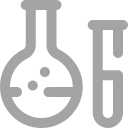
Product Description
Mifepristone is a progesterone receptor (PR) antagonist (IC50=0.2 nM) in a T47D cell-based assay, also is a glucocorticoid receptor (GR) antagonist (IC50=2.6 nM) in an A549 cell-based assay.
IC50 & Target: IC50: 0.2 nM (progesterone receptor, in T47D cells), 2.6 nM (glucocorticoid receptor, in A549 cells)[1]
In Vitro: The discovery of the first competitive progesterone antagonist, Mifepristone, has stimulated an intense search for more potent and more selective antiprogestins[1]. Cell growth is evaluated after 4 days of exposure to Mifepristone at 10 μM, a concentration close to the plasma concentration achievable in humans. The antiproliferative effect of Cisplatin is potentiated when administered in combination with Mifepristone in HeLa cells. The IC50 of Cisplatin in combination with Mifepristone is lower (14.2 μM) than that of Cisplatin alone (34.2 μM) in HeLa cells with an approximately 2.5-fold difference. After treatment with Mifepristone, the accumulation of intracellular Cisplatin in HeLa cells is 2-fold greater, representing a significant difference (p=0.009), compare with Cisplatin alone from 0.79 to 1.52 μg/mg of protein[2].
In Vivo: The cervix tumor xenograft models are treated with Cisplatin alone, there is a tumor growth inhibition compare with control group. However, the tumor weight loss is even more significant (p<0.05) with the combination of Cisplatin and Mifepristone at the doses used, showing a decrease of ~50% compared with the treatments alone by the end of the study[2]. Adult male Sprague-Dawley rats are subjected to a 4-day binge-like EtOH administration regimen (3 to 5 g/kg/i.g. every 8 hours designed to produce peak blood EtOH levels (BELs) of <300 mg/dL). Subgroups of animals receive s.c. injection of Mifepristone (20 or 40 mg/kg in peanut oil). Although Mifepristone produces no significant changes in behavior of EtOH-naïve animals, pretreatment with Mifepristone (40 mg/kg) significantly reducesthe severity of EtOH withdrawal. Asignificant interaction between diet and drug, F(5,55)=3.92, p<0.05, such that EtOH-treated animals receiving vehicle or 20 mg/kg of Mifepristone displayssignificantly more signs of EtOH withdrawal than does EtOH-naïve animals receiving the same drug treatment. Importantly, treatment with 40 mg/kg of Mifepristone significantly reduces the severity of EtOH withdrawal, in a dose-dependent manner[3].

Information
CAS No84371-65-3
FormulaC29H35NO2
Clinical Informationclinicalinformation
PathwayOthers
GPCR/G Protein
Autophagy
TargetProgesterone Receptor
Glucocorticoid Receptor
Autophagy

Specifications
Purity / Grade>98%
SolubilityDMSO : ≥ 59 mg/mL (137.34 mM)
Smilessmiles

Misc Information
Alternative NamesRU486;RU 38486
Observed Molecular Weight429.59